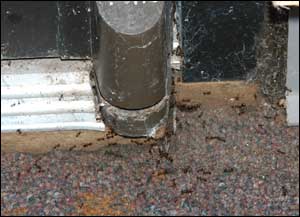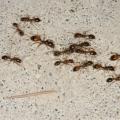Indoor Fire Ant Invasions
Fire ants are outdoor, soil-dwelling insects. They rarely invade buildings, but when they do, they usually cause problems.
Indoor fire ant invasions happen for two reasons. The first is when foraging workers wander into a building, find a food source, such as pet food or spilled food crumbs, and recruit other workers to this food source. This results in a trail of workers traveling back and forth from the outside nest to the inside food source and a concentration of ants around the food source.
The second cause of indoor fire ant invasions is when an entire colony of fire ants attempts to relocate because of disturbance by flooding, drought, landscaping or other causes. This is less common, but more distressing. In this case, you usually see large numbers of workers carrying their white brood into the house. They may also bring particles of soil inside. These displaced colonies are usually very agitated and will sting aggressively and in large numbers. They have to be controlled quickly and effectively. See Extension Publication 2443, Control Household Insect Pests, Pages 15-16, for more details on how to control and prevent indoor fire ant invasions.
Contact information for Dr. Blake Layton.
Publications
News
Sunshine and long days make summertime in the South desirable for people, but those same conditions are exactly what allows the dreaded, imported fire ants to thrive.
Almost any sunny, grassy area left unattended will soon be home to fire ants. Fire ants were accidentally imported from South America to Mobile in the 1930s and have since spread throughout the Southeast.
Everyone loves a good myth buster, and we have a very timely one for you! Fire ant beds in your yard can be such a headache to deal with. Many people have used home remedies to control ants. But are those quick fixes really getting rid of the ants in your yard? Let’s take a look at some commonly used home remedies and whether or not they work!
Do you have fire ants in your vegetable garden? Me too. Good news for all of us! There are some fire ant baits that are safe to use around food plants.




